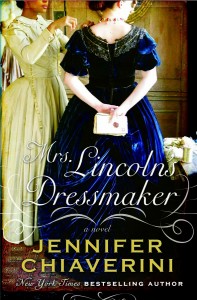Period piece reflects on changing times
The past few months have been filled with references to Abraham Lincoln: political comparisons concerning President Barack Obama, Spielberg’s highly acclaimed film Lincoln and even the 150th anniversary of the Emancipation Proclamation. What could be more timely than a book about a close personal friend of the Lincoln family, so often overlooked by historians and artists alike?
Mrs. Lincoln’s Dressmaker, written by New York Times bestselling author Jennifer Chiaverini, is an enchanting novel that draws the reader into the lives of the main character and those around her. Though not a literary masterpiece, it succeeds in immersing the reader in the time period of the Civil War through the turn of the 20th century.
The novel explores the life of Elizabeth Keckley, a former slave who purchased her freedom before the Civil War and became a mantua maker in Washington, D.C. The story follows her term as dressmaker for First Lady Mary Todd Lincoln and details their long friendship through all its ups and downs. Mrs. Lincoln’s Dressmaker starts on election day in 1860, setting up the arrival of the Lincolns in Washington. Elizabeth’s position as a dressmaker is already well established, with an impressive list of clients including Varina Davis (the wife of soon-to-be Confederate President Jefferson Davis).
When Elizabeth achieves the patronage of Mary Todd and becomes her modiste, or clothing designer, she becomes intimately and irrevocably intertwined in the lives of the Lincolns. She makes Mary Todd’s dresses in her apartments, prepares her for levees and even becomes her closest friend and confidante during the early years of the Civil War, when a series of losses disheartens the entire Union. Though there is never the sense that the North might actually lose the war (an oddity given the severity of the losses), the poignant deaths come fast and furious in the beginning of the novel. After Keckley’s painful loss early in the novel, one nearly questions whether to continue reading because of the book’s manner of literary style and content.
That being said, it is definitely worth doing so, particularly because the biggest strength of this book is its vividly etched characters. Elizabeth changes very little throughout the novel, as she is already 42 years old at the start of the story. She is, however, a very real and likeable character, hardworking and proud of her accomplishments despite a horrific childhood in slavery.
President Lincoln is not overplayed in any way, as we most often see the domestic version of “The Great Emancipator.” He garners the respect of both Elizabeth and the reader through his determination and humanity. Mary Todd Lincoln, on the other hand, reads as a dramatic and larger-than-life character whose mood swings are sharp and severe. Elizabeth exists as the rock of the First Lady, through the assassination of Mary Todd’s husband and financial crises. The relationship between the two women is believable, poignant and the mainstay of this novel. The prose helps with this, as it neither detracts nor stuns; it’s a strong narrative and yet doesn’t distract the reader from the characters.
Writers of historical fiction sometimes struggle with historical themes that, while important to timeline the novel takes place in, are otherwise unrelated to the story itself. However, the fight for the emancipation and further rights of black Americans that occurs during Elizabeth’s time period fits perfectly with the novel’s theme. As a legally emancipated slave, Elizabeth deeply concerns herself with the president’s plan for national emancipation. As Mrs. Lincoln’s Dressmaker progresses, she throws herself into charitable activities for newly freed slaves who lack accommodations, funding or any sort of skills that might help them survive in a city full of jobs for which they are not trained. Though her race and gender would seem to work against her in a world dominated by white males, Elizabeth’s hopes and achievements are inspirations to all those around her. This adds an extra dimension to the book, whose title would suggest that it focuses nearly exclusively on the relationship between Elizabeth and Mary Todd.
The main issue with this novel shouldn’t be blamed on Chiaverini, but it’s an issue nonetheless: Elizabeth lived for a very long time. Though the book doesn’t start until she is 42, she lived to be nearly 90 years old. Thus, despite its short 352-page length, the book covers almost 50 years’ worth of her life and the many important moments in it.
The book starts out with a bang, as the United States plunges nearly immediately into a long and bloody civil war. After the assassination of President Lincoln, though, the book lags through the grief of Mary Todd and her seemingly perpetual mourning. The events that follow in the narrative, though historically accurate and very important to the life of Elizabeth Keckley and her long friendship with Mary Todd, seem slightly ridiculous in comparison to the book’s momentous beginning. They do not feel important enough to warrant the time spent on them and would be very dull indeed if not for the constant desire to know what shall become of the protagonist.
Though this novel does get bogged down in historical necessity from time to time, it’s worth reading the story of an incredible woman who is so often overlooked, despite her important position and her written memoir.
The friendship between Elizabeth Keckley and Mary Todd Lincoln, though not the sum total of the book, deeply impacts and fascinates the reader. The emotional journey of Elizabeth is also beautiful, as she lives as a freed woman who experiences continual reminders of her still-inferior place in a post-emancipation society.
The novel would be depressing if she ultimately despaired; however, it’s a hallmark of her character that she never gives up hope, lending a positive note to a remarkable story that stretches through an era of death and sorrow.
